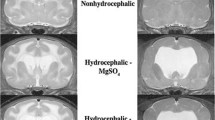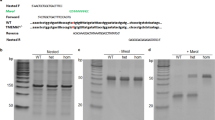Summary
Prenatal methylmercury poisoning of C57BL/6J mice was followed by the development of communicating hydrocephalus in 15% to 25% of surviving offspring. Although examination of the serially sectioned cerebral aqueduct in hydrocephalic animals revealed the presence of stenosis, complete occlusion of the lumen was not observed. The ependymal epithelium of the cerebral aqueduct was preserved, and there was no evidence of periaqueductal inflammation or reactive gliosis. Edema and vacuolar change were, however, observed subependymally. The cerebral white matter, which bore the brunt of the degenerative changes seen in hydrocephalic brains, showed edema, spongy degeneration, gross cystic change and loss of parenchyma. In addition, ependymal cells and choroid plexus epithelial cells in Hg-treated animals contained large amounts of mercury within their cytoplasm, and it is possible that this may have contributed to the development of hydrocephalus by causing disturbances of CSF homeostasis. We believe that the appearance of aqueductal stenosis in Hg-intoxicated animals represents the result rather than the cause of the hydrocephalus.
Similar content being viewed by others
References
Ahdab-Barmada M, Moossy J, Preble OT, Younger JS (1982) Hydrocephalus in weanling mice induced by a temperature-sensitive mutant of vesicular stomatitis virus. J Neuropathol Exp Neurol 41:606–617
Aikawa H, Suzuki K, Ito N, Iwasaki Y, Nonaka I (1984) 6-Aminonicotinamide-induced hydrocephalus in suckling mice. J Neuropathol Exp Neurol 43:511–521
Amin-Zaki L, Elhassani S, Majeed MA, Clarkson TW, Doherty RA, Greenwood MR (1974) Intra-uterine methylmercury poisoning in Iraq. Pediatrics 54:587–595
Borit A, Sidman RL (1972) New mutant mouse with communicating hydrocephalus and secondary aqueductal stenosis. Acta Neuropathol (Berl) 21:316–331
Bornhausen M, Musch HR, Greim H (1980) Operant behavior performance changes in rats after prenatal methylmercury exposure. Toxicol Appl Pharmacol 56:305–310
Choi BH (1984) Cellular and subcellular demonstration of mercury in situ by modified sulfide-silver technique and photoemulsion histochemistry. Exp Mol Pathol 40:109–121
Choi BH (1986) Methylmercury poisoning of the developing nervous system. I. Pattern of neuronal migration in the cerebral cortex. Neurotoxicology 7:591–600
Choi BH, Lapham LW, Amin-Zaki L, Saleem T (1978) Abnormal neuronal migration, deranged cerebral cortical organization, and diffuse white matter astrocytosis of human fetal brain: a major effect of methylmercury poisoning in utero. J Neuropathol Exp Neurol 37:719–733
Drachman DA, Richardson EP Jr (1961) Aqueductal narrowing, congenital and acquired. Arch Neurol 5:552–559
Fiori MG, Sharer LR, Lowndes HE (1985) Communicating hydrocephalus in rodents treated withβ,β′-iminodipropionitrile (IDPN). Acta Neuropathol (Berl) 65:209–216
Friedheim E, Covi C, Graziano J, Donnelli T, Breslin D (1983) Choroid plexus as protective sink for heavy metals? Lancet 1:981–982
Fujita E (1969) Experimental studies of organic mercury poisoning. The behavior of the Minamata disease-causing agent in maternal bodies, and its transfer to their infants via either placenta or breast milk. J Kumamoto Med Soc 43:47–57
Fuyuta M, Fujimoto T, Hirata S (1978) Embryotoxic effects of methylmercury chloride administered to mice and rats during organogenesis. Teratology 18:353–366
Fuyuta M, Fujimoto T, Kiyofuji E (1979) Teratogenic effects of a single oral administration of methylmercuric chloride in mice. Acta Anat (Basel) 104:356–362
Garman RH, Weiss B, Evans HL (1975) Alkylmercurial encephalopathy in the monkey (Saimiri sciureus andMacaca arctoides). Acta Neuropathol (Berl) 32:61–74
Harada Y (1968) Congenital (or fetal) Minamata disease. In: Kutsuna M (ed) Minamata disease, Study group of Minamata disease. Kumamoto University Press, Kumamoto, Japan, pp 93–117
Harris SB, Wilson JG, Prinz RH (1972) Embryotoxicity of methylmercuric chloride in golden hamsters. Teratology 6:139–142
Hunter D, Russell DS (1954) Focal cerebral and cerebellar atrophy in a human subject due to organic mercury compounds. J Neurol Neurosurg Psychiatry 17:235–241
Johnson RT, Johnson KP (1968) Hydrocephalus following viral infection: the pathology of aqueductal stenosis developing after experimental mumps virus infection. J Neuropathol Exp Neurol 27:591–606
Kesterson JW, Carlton WW (1970) Aqueductal stenosis as the cause of hydrocephalus in mice fed the substituted hydrazine cuprizone. Exp Mol Pathol 13:281–294
Khera KS (1973) Teratogenic effects of methylmercury in the cat. Note on the use of this species as a model for teratogenicity studies. Teratology 8:293–304
Kilham L, Margolis G (1969) Hydrocephalus in hamsters, ferrets rats and mice following inoculation with reovirus type 1. Lab Invest 21:183–188
Mansour MM, Dyer NC, Hoffman LH, Davies J, Brill AB (1974) Placental transfer of mercuric nitrate and methylmercury in the rat. Am J Obstet Gynecol 119:557–562
Masters C, Alpers M, Kakulas B (1977) Pathogenesis of reovirus type 1 hydrocephalus in mice. Significance of aqueductal changes. Arch Neurol 34:18–28
Matsumoto H, Koya G, Takeuchi T (1965) Fetal Minamata disease. J Neuropathol Exp Neurol 24:563–574
McComb JG (1983) Recent research into the nature of cerebrospinal fluid formation and absorption. J Neurosurg 59:369–383
Mehra M, Choi BH (1981) Distribution and biotransformation of methylmercuric chloride in different tissues of mice. Acta Pharmacol Toxicol (Copenh) 49:28–37
Murakami U (1972) The effect of organic mercury on intrauterine life. Adv Exp Med Biol 27:301–336
Nugent GR, Al-Mefty O, Chou S (1979) Communicating hydrocephalus as a cause of aqueductal stenosis. J Neurosurg 51:812–818
Raimondi AJ, Clark SJ, McLone DG (1976) Pathogenesis of aqueductal occlusion in congenital murine hydrocephalus. J Neurosurg 45:66–77
Schalock RL, Brown WJ, Kark RAP, Menon NK (1981) Perinatal methylmercury intoxication: behavioral effects in rats. Dev Psychobiol 14:213–219
Snyder RD (1971) Congenital mercury poisoning. N Engl J Med 284:1014–1016
Spyker JM, Smithberg M (1972) Effects of methylmercury on prenatal development in mice. Teratology 5:181–190
Stempak JG (1964) Etiology of trypan blue-induced antenatal hydrocephalus in the albino rat. Anat Rec 148:561–571
Su M, Okita G (1976) Embryocidal and teratogenic effects of methylmercury in mice. Toxicol Appl Pharmacol 38:207–216
Takeuchi T, Morikawa N, Matsumoto H, Shiraishi A (1957) Pathologic study of Minamata disease in Japan. Acta Neuropathol (Berl) 2:40–57
Wannag A, Skejerasen J (1975) Mercury accumulation in placenta and fetal membranes. A study of dental workers and their babies. Enyiron Physiol Biochem 5:348–352
Williams B (1973) Is aqueduct stenosis a result of hydrocephalus? Brain 96:399–412
Author information
Authors and Affiliations
Additional information
Supported in part by USPHS grant no. ES 02928
Rights and permissions
About this article
Cite this article
Choi, B.H., Kim, R.C. & Peckham, N.H. Hydrocephalus following prenatal methylmercury poisoning. Acta Neuropathol 75, 325–330 (1988). https://doi.org/10.1007/BF00687784
Received:
Accepted:
Issue Date:
DOI: https://doi.org/10.1007/BF00687784




